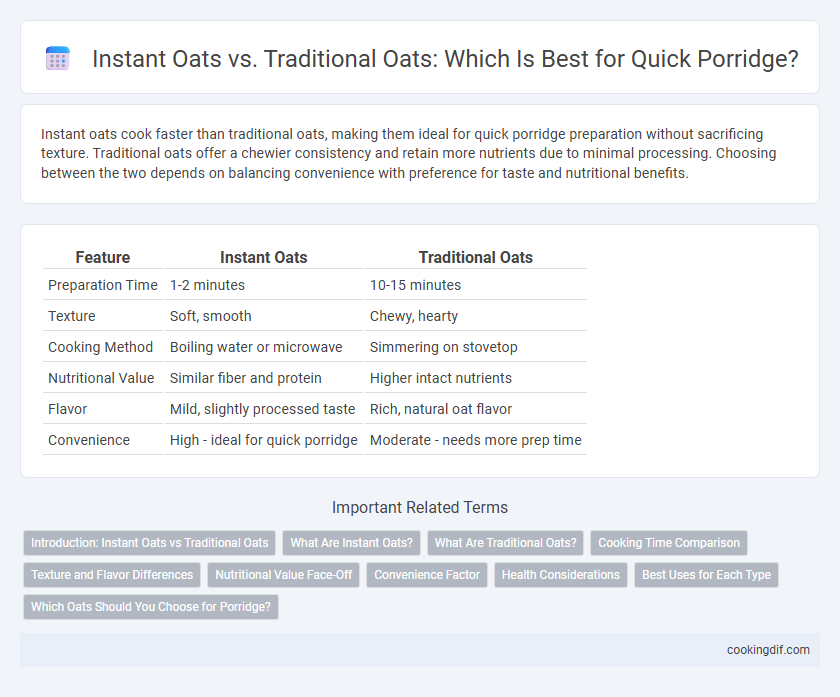Instant oats cook faster than traditional oats, making them ideal for quick porridge preparation without sacrificing texture. Traditional oats offer a chewier consistency and retain more nutrients due to minimal processing. Choosing between the two depends on balancing convenience with preference for taste and nutritional benefits.
Table of Comparison
| Feature | Instant Oats | Traditional Oats |
|---|---|---|
| Preparation Time | 1-2 minutes | 10-15 minutes |
| Texture | Soft, smooth | Chewy, hearty |
| Cooking Method | Boiling water or microwave | Simmering on stovetop |
| Nutritional Value | Similar fiber and protein | Higher intact nutrients |
| Flavor | Mild, slightly processed taste | Rich, natural oat flavor |
| Convenience | High - ideal for quick porridge | Moderate - needs more prep time |
Introduction: Instant Oats vs Traditional Oats
Instant oats offer a faster cooking time and softer texture compared to traditional oats, making them ideal for quick porridge preparation. Traditional oats, such as steel-cut or rolled oats, provide a chewier texture and a richer, nuttier flavor but require longer cooking. Nutritionally, both types retain essential fiber and protein, with minimal differences in health benefits.
What Are Instant Oats?
Instant oats are pre-cooked, dried, and finely rolled oats designed for rapid preparation, typically requiring only hot water or a brief microwave session. Their thin texture and reduced cooking time make them ideal for quick porridge, providing a convenient breakfast option without sacrificing essential nutrients like fiber and vitamins. Unlike traditional oats, which are less processed and take longer to cook, instant oats prioritize speed and ease of use while maintaining a similar nutritional profile.
What Are Traditional Oats?
Traditional oats refer to whole oat groats that have been steamed and flattened into flakes, preserving most of their natural fiber and nutrients. They require longer cooking times, typically around 10 to 15 minutes, making them a heartier option for porridge with a chewier texture. Rich in beta-glucan, traditional oats support cholesterol reduction and sustained energy release, making them a nutritious base for quick porridge when pre-soaked or cooked efficiently.
Cooking Time Comparison
Instant oats cook in about 1 to 2 minutes, making them ideal for quick porridge preparation, while traditional oats require 10 to 15 minutes of cooking time. The difference stems from the finer processing of instant oats, which reduces their thickness and cooking duration. Choosing instant oats significantly speeds up meal preparation without compromising on essential nutrients.
Texture and Flavor Differences
Instant oats have a finer, thinner texture that cooks rapidly, producing a smoother, creamier porridge but with a milder, less complex flavor. Traditional oats, such as old-fashioned or steel-cut, offer a chewier texture and retain more of the oat's natural nutty taste, enhancing the overall flavor profile. The choice between instant and traditional oats directly impacts the porridge's mouthfeel and depth of flavor, balancing convenience against a richer culinary experience.
Nutritional Value Face-Off
Instant oats offer faster cooking times but often contain added sugars and lower fiber content compared to traditional oats, which retain more nutrients and have a denser fiber profile. Traditional oats provide higher levels of beta-glucan, a soluble fiber linked to improved heart health and blood sugar regulation. Choosing traditional oats maximizes nutritional benefits while supporting sustained energy release during breakfast.
Convenience Factor
Instant oats are finely processed and pre-cooked, allowing them to prepare within 1 to 2 minutes, offering unmatched convenience for quick porridge. Traditional oats, such as steel-cut or rolled oats, require longer cooking times ranging from 10 to 30 minutes, which may not suit busy schedules. For individuals prioritizing speed and ease, instant oats provide a practical solution without sacrificing nutritional benefits.
Health Considerations
Instant oats offer convenience for quick porridge preparation but typically contain added sugars and sodium that can impact heart health. Traditional oats retain more fiber, antioxidants, and essential nutrients, promoting better blood sugar control and digestion. Choosing steel-cut or rolled oats ensures higher nutritional value and lower glycemic response compared to instant oat varieties.
Best Uses for Each Type
Instant oats dissolve rapidly in hot water, making them ideal for quick breakfast options and smooth-textured porridges that require minimal preparation time. Traditional oats, including rolled or steel-cut varieties, provide a chewier texture and richer flavor, suitable for slow-cooked porridges or recipes that benefit from longer cooking to enhance nutritional value. For convenience and speed, instant oats excel in on-the-go meals, while traditional oats offer versatility for hearty, customizable porridge dishes.
Which Oats Should You Choose for Porridge?
Instant oats are processed for faster cooking, making them ideal for quick porridge with a smoother texture, while traditional oats retain more nutrients and a chewier consistency, offering a heartier option. Nutritionally, traditional oats have slightly higher fiber content and a lower glycemic index, supporting better blood sugar control. Choose instant oats for convenience and speed, but opt for traditional oats when seeking more texture and nutritional benefits in your porridge.
Instant Oats vs Traditional Oats for Quick Porridge Infographic

 cookingdif.com
cookingdif.com